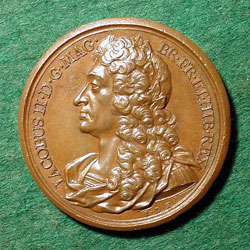

|
JAMES II |
|
|
James II (1633 - 1701), Duke of York (1634-1685), and King of England, Scotland and Ireland (1685-1688), was the third son to Charles I and Henrietta Maria. During the Civil War he fled to France but returned to England and became king after the death of his older brother Charles II, who had been restored to the throne after Cromwell's Commonwealth collapsed. Unlike his brother, James maintained a strong adherence to the Roman Catholic faith. He married a Roman Catholic princess, Mary of Modena, and tried to convert England to Catholicism. His zealous piety and his determination to impress Catholicism on his subjects was to prove his nemesis. Within days of James' accession, Protestants began rallying around Charles' son, James, Duke of Monmouth, whom they believed should be king. The rebellion was easily quashed and Monmouth was beheaded. Continuing his religious campaign, James had Catholics promoted to high-status positions while he appointed the 'Bloody Assizes' to execute, torture or enslave Protestant rebels. The Declaration of Indulgence (1687) granted tolerance of Catholics and non-conformists. In response, both Tories and Whigs turned against the king. On the birth of his son, James was deposed in the Glorious Revolution of 1688, the Protestant Parliament having allied themselves with James' Protestant daughter Mary (Mary was the daughter of Jamesí first wife Anne Hyde, a Protestant who raised her daughter in the same faith), and her husband William of Orange, who eventually took the throne of England as William and Mary. That revolution, engendered by Jamesí Roman Catholicism, permanently established Parliament as the ruling power of England. James died an exile in Saint-Germain, the last Stuart monarch in the direct male line (Queen Anne being the last Stuart monarch). (From www.bbc.co.uk) |
|